Three Important Ingredients To Make Music Tone, Harmony, Rhythm


There is a universal love for music built into the soul of mankind. From the very day we are born to the day we die, music surrounds our lives. Music is a universal language that affects the way we act or feel. As a music composer, it is important to understand the fundamental elements that make music. To get understanding, there are three key elements that make music what it is. These elements include:
- Tone
- Rhythm
- Harmony
Before diving into the explanation of the three elements that make music, let’s talk about musical styles. Musical styles are how music is categorized. These categories are called genre. Musical tastes are developed by what we listen to and depending on the genre of music we either like it or we don’t. The truth is each individual will gravitate to music they like and enjoy. A big factor in shaping musical taste is culture and environment. Even if each style is different from the other, they all have the three elements in common. Let’s take a look are each element and discover its role in making music.
Make Music: Tones
The first element is tone. The tone is a sound frequency that vibrates the air. This vibration makes waves. The shorter the frequency the higher the tone is. The longer the frequency the lower the tone is. These different frequency tones create something called pitch. The pitch will rise and fall making a melody. Of the three elements the tone is one of the most recognizable. As the musical pitch rise and fall emotion will start to come out of the music. Most melody lines are written on the treble clef. The absence of tone makes it very difficult to imagine a melody. But tone alone does not make music. To help you with musical tone shapes go to the Melody Shape Generator for ideas
Make Music: Rhythm
Music needs rhythm. The basis of rhythm is the beat. A beat is a measurement of time. As music is performed it travels though time. Beats are designated by a time signature and tempo. The tempo is the number of beat in a minute of music while the time signature divides beats into smaller groups. The foundation of most musical beats is the quarter note. A piece of music that is 120 beats per minute will have 120 quarter notes played during that time. A measure provides a way to divide the music in to manageable chunks. Assuming the time signature is 4/4 it will have four quarter notes per measure.
Now music would get real boring is all the tones were played with an even beat consisting of nothing more than quarter notes. Some notes are played longer and some are played for shorter durations. Add to the element of silence called rests in music. Rhythm starts to form.
In order for rhythm to really be effective in music it needs to develop patterns. A sequence of long and short sounds repeated will create an effective rhythm. The role of the music composer is to blend these rhythms to the tones. As this is done a melody starts to emerge. A melody is the combination of tone and rhythm that creates musical statements. To get ideas for rhythm patterns use the Random Rhythm Motif Generator tool.
Make Music: Harmony
The third element that goes into making music is called harmony. Harmony consists of additional tones that are added to a song’s melody. These tones create fullness to the music. Depending on the tones used will help create different emotional feeling to the tone. Without harmony a song would feel empty. Most harmony is created by chord progressions. Chord progressions are a sequence of chords that are repeated in a song. For chord progression ideas visit the Interactive Chord Progression tool
Music consists of three basic parts. The tone which is a frequency that creates a pitch that goes up or down. A rhythm of long and short beats in recognizable pattern is added to the tones. And the third part which is harmony that added fullness and additional emotion to the music.
As you continue in your journey it is important to learn the nuances of music. This can take a lifetime to learn all there is to music. Understanding these three elements of tone, rhythm and harmony will improve the way you approach writing music.





Leave a Reply